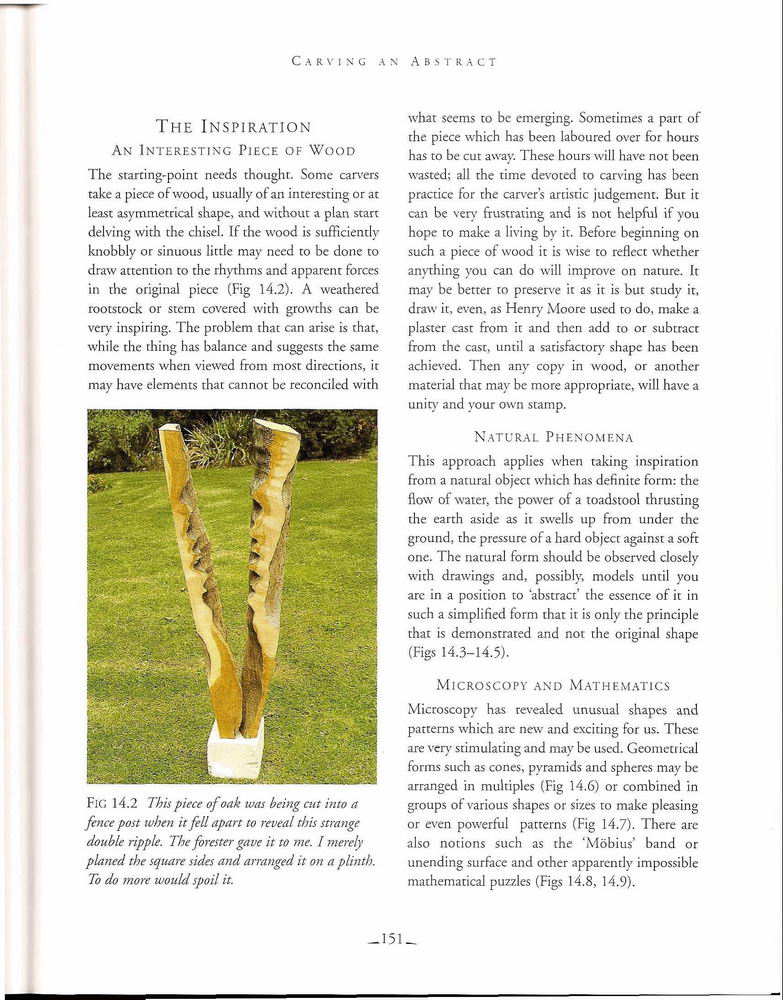essentÊrving±51

C A R V | N G A N A B S T R A C T
The Inspiration An Interesting Piece of Wood The sra rting-point needs thought. Somc carvers take a piece of wood, usually of an interesting or at least asymmetrical shape, and without a plan start delving with the chisel. If the wood is sufficiendy knobbly or sinuous little may need to be done to draw atcention to the rhythms and apparent forces in the original piece (Fig 14.2). A weathered rootstock or stem covered with growths can be very inspiring. The problem that can arise is that, whilc the thing has balance and suggests the same movemcnts when viewed froin most dircctions, it may have elcments that cannot be reconcilcd with

FlC 14.2 This piece of oak was being cut i u to a fence post when it fell apart to reoeal this strange double ripple. The forester gaue it to me. I merely planed the sąuare sides and arranged it on a plinth. To do morę would spoił it.
what sccms to be cmerging. Sometimes a part of the piece which has been laboured over for hours has to be cut away. These hours will have not been wasted; all the time devotcd to carving has been practicc for the carvers artistic judgement. But it can be very frustrating and is not helpful if you hopc to make a living by it. Before beginning on such a piece of wood it is wise to reflcct whether anything you can do will improve on naturę. It may be better to preserve it as it is but study it, draw it, even, as Henry Moore used ro do, make a plaster cast from it and then add to or subtracr from the cast, until a sarisfactory shape has been achicved. Then any copy in wood, or another materiał that may be morę appropriate, will havc a unity and your own stamp.
Natural Phenomena
This approach applies when taking inspiration from a natural objcct which has definite form: the flow of water, the power of a toadstool rhrusting the earth aside as it swells up from under the ground, the pressure of a hard object against a soft one. The natural form should be observed closely with drawings and, possibly, models until you arc in a position to abstract’ the essence of it in such a simplified form that it is only the principle that is demonstrated and not the original shape (Figs 14.3-14.5).
Microscopy and Mathematics
Microscopy has revealed unusual shapes and patterns which arc new and exciting for us. These are very stimulatingand may be used. Geomettical forins such as cones, pyramids and spheres may bc arranged in multiples (Fig 14.6) or combined in groups of various shapes or sizes to make pleasing or even powerful patterns (Fig 14.7). There arc also notions such as the ‘Mobius’ band or unending surface and other apparcntly impossible mathematical puzzles (Figs 14.8, 14.9).
_151_
Wyszukiwarka
Podobne podstrony:
An interesting feature of eunuchs is that they pass on sexual overtures to the generał population, e
S5006938 (2) not only their late chronological position but is also an important piece of evidence a
88115 mus dev(7) 19 GEORGE SULLIVAN An interefting posc of thi» athletc. What is morę pleasiof to th
essent?rving?27 CHAPTER 2SELECTING AND BUYING SUITABLE WOOD The Beginner’s Experience Thcrc is
essent?rving?29 S E L E C T I X C. AND B l Y I N G SlIT A B L E W O O D FlC 2.2 A piece of linie wo
essent?rving?03 C A R V I N G IN THE R O U N D leave a piece of rhe wood which can bc sacrificed at
1 Introduction The topie of standardisation and customisation is an interesting issue which mixes th
essent?rving?30 Essen ti al Woodcarving Techniques Fig 2.4 A piece of Southern yeUow pine. The dark
essent?rving?41 S E L E C T I X G AND B VV I N G SUITABLE W O O D Fic 2.22 The brown lines on the ne
essent?rving?65 CHAPTER 5FOLIAGE:COPYING A NATURAL LEAF IN WOOD The usc of foliage as a subjcct for
essent?rving?68 E S 5E NTI A L W O O D C A R VIN G TECHNIQLES Fig 5.6 The gouge can removeplenty of
essent?rving?84 Essential Woodcarving Techniques Fig 7.7 This is how a piece of card would look if f
essent?rving?20 Essen tial Woodcarving T e c h n i q u e sChoosing the BestDlRECTION OF THE GRAIN Th
więcej podobnych podstron